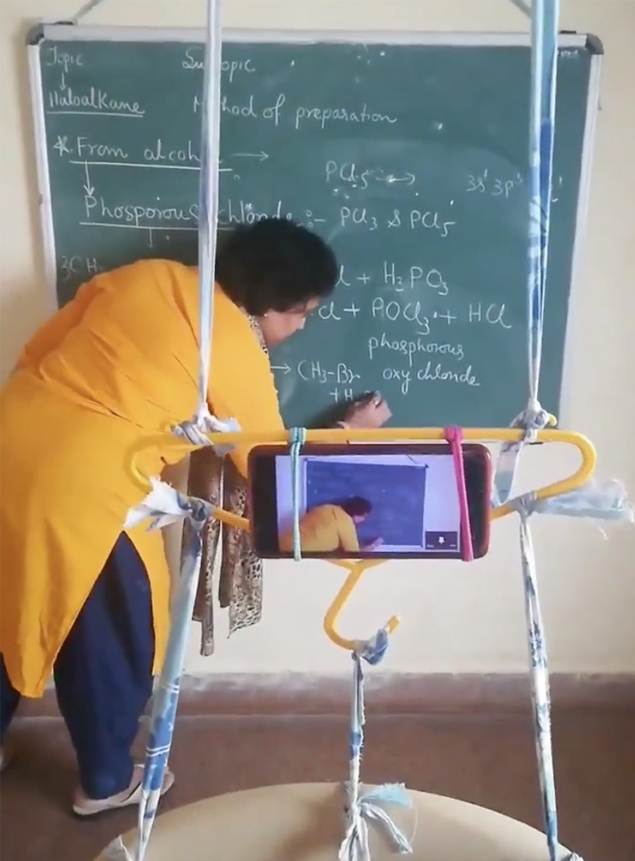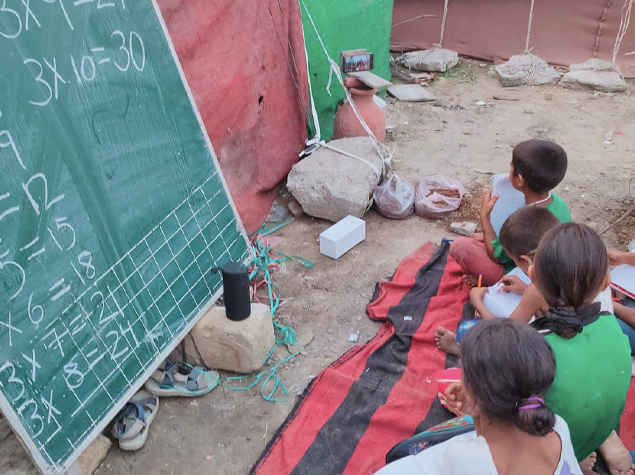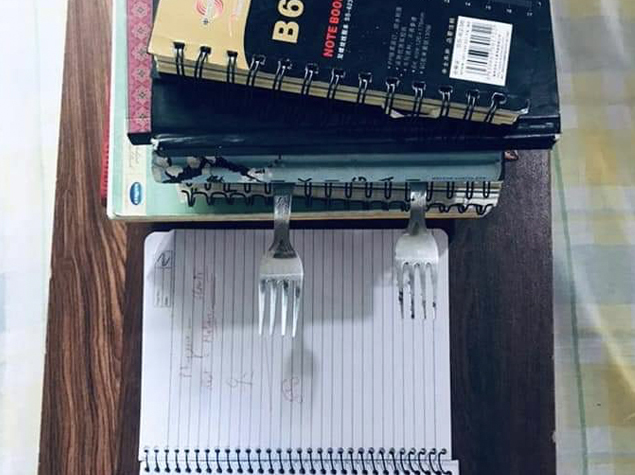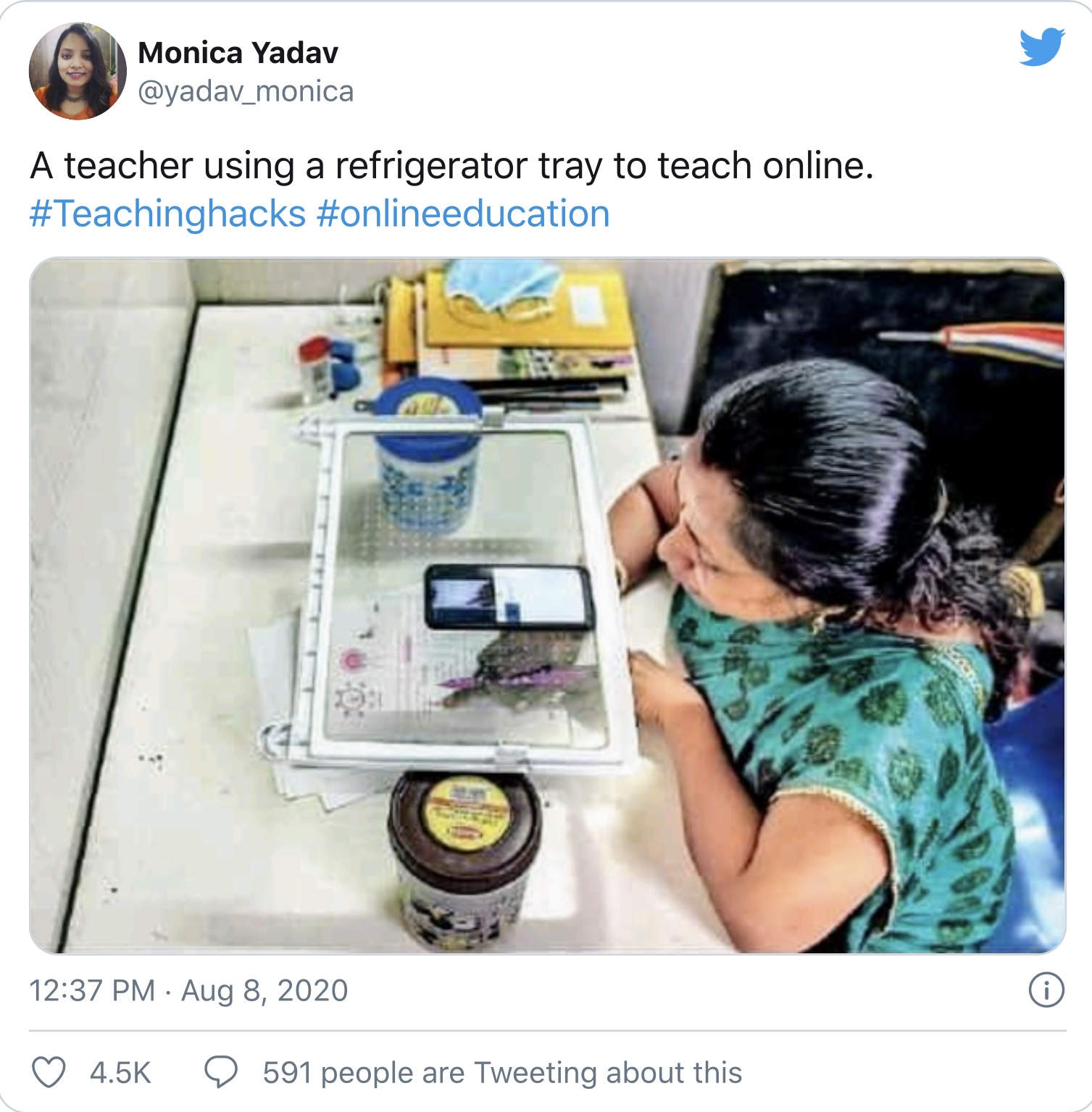
- Good Stuff -
- 5mins -
- 1,415 views
Indian teachers praised for their creativity with “desi-hacks” to bring the classroom to students
Household items such as books, glasses and dining forks are being utilised to mount and support cellphones as India’s school teachers replicate classroom learning.
“Jugaad” reintroduces the blackboard to remote learning
The move to virtual learning has thrown up challenges for India’s educators — keeping the class engaged, ensuring learning is easy — and all of this armed with just a smartphone or a laptop. Many teachers told the Times of India that blackboards — the ubiquitous teaching tool in classrooms — were integral to collaborative learning, and so that’s why they are coming up with creative “jugaaad” or “desi-hacks” to reintroduce the blackboard while taking digital classes.

Jugaad (or desi-hacks)
Jugaad जुगाड is a colloquial Hindi, Bengali, Marathi, Punjabi, Sindhi and Urdu word, which refers to a non-conventional, frugal innovation, often termed a "hack" or “desk-hack”. It could also refer to an innovative fix or a simple work-around, a solution that bends the rules, or a resource that can be used in such a way. Household items such as books, glasses and pen stands are being utilised to mount and support cellphones while teachers replicate classroom learning, solving problems on paper, cardboard and chalkboards.

India’s educators get creative with “Jugaad”
Moumita Bhattacharjee, a chemistry teacher at a Pune school, set up a makeshift ‘tripod’ that would allow students to watch her solving equations on the board. Her photo — showing a mobile phone hanging from the ceiling fan, placed carefully on a cloth hanger and tied to a chair using spare bits of cloth — went viral on social media this month. Since then, several netizens have approached her, offering to buy her a tripod that would make her job easy, Bhattacharjee told TOI.
“It was difficult to teach chemistry without a board since it requires a lot of explanation. My children held the phone initially, but they would get tired quickly so I came up with this hack of sorts. I had no idea it would get this kind of response,” she said.
Chandi Prasad Kothiyal’s DIY project includes an old cellphone box attached to a ruler. The box has a large hole so when the phone is placed inside, its camera is not obstructed. The ruler is wedged in between a stack of books at a height, allowing the camera to focus on the paper placed below on the table. “This allows students to see whatever I’m writing on the paper and helps them understand it better,” said the science teacher at a government school in Tehri Garhwal.
Source: TimesOfIndia

Without the hacks their teachers employed, many would have missed lessons for many months
YouTube videos can also help educators learn a hack or two. Surbhi Arora, founder director of a career coaching and e-learning website, has been sharing tips and creative ways teachers can adapt to online teaching on YouTube. “A popular hack for teachers to easily record videos that I shared was placing forks in the middle of a stack of books and placing the phone on it. It was an instant hit.”
In Meerut’s Lalkurti slum, a smartphone atop a matka (earthen pot) propped up by bricks makes for a strange sight, but for kids of the area it’s their “classroom”.
Every evening, a dozen children gather in an open space outside their houses to listen to their teacher — Shantanu Sharma — as he appears on the smartphone screen, his voice echoing on a Bluetooth speaker connected to the phone. “I have been part of a volunteer initiative — Udgam Classes — to teach underprivileged kids for over a year now. But our lessons were disrupted during the lockdown. We talk of online classes, but many families don’t have access to internet or mobile devices. How do you make sure such students don’t suffer?” said Sharma.
The 22-year-old then approached one of the families in the area which had access to a smartphone and they agreed to lend their device for two hours every day. Sharma then arranged for a speaker. With the help of bricks, planks and pots, the smartphone was then set up at an angle from where it was visible to the children, allowing them to resume classes.
Those being taught said without the hack their teacher employed they would have missed lessons for many months. “In the initial days of the lockdown, we were unable to study but then we got these online classes over a smartphone. It’s fun to learn and our teacher often cracks jokes to keep us engaged.”
Source: TimesOfIndia




